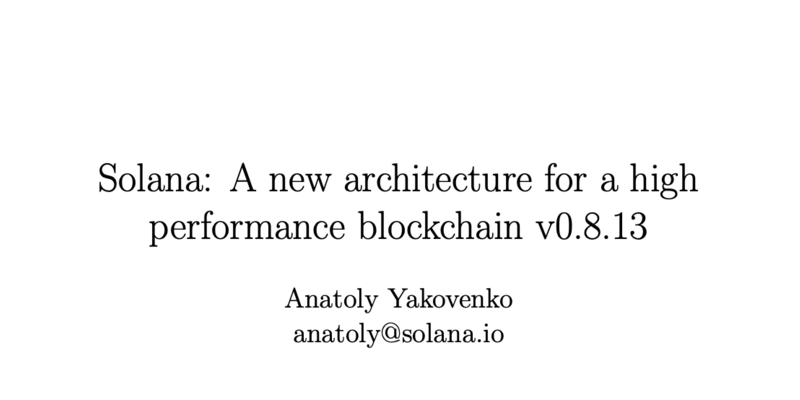
Solana Whitepaper
Abstract
This paper proposes a new blockchain architecture based on Proof
of History (PoH) - a proof for verifying order and passage of time between events. PoH is used to encode trustless passage of time into a ledger - an append only data structure. When used alongside a consensus algorithm such as Proof of Work (PoW) or Proof of Stake (PoS), PoH can reduce messaging overhead in a Byzantine Fault Tolerant replicated state machine, resulting inn sub-second finality times.
This paper also proposes two algorithms that leverage the time keeping properties of the PoH ledger - a PoS algorithm that can recover from partitions of any size and an efficient streaming Proof of Replication (PoRep). The combination of PoRep and PoH provides a defense against forgery of the ledger with respect to time (ordering) and storage. The protocol is analyzed on a 1 gbps network, and this paper
shows that throughput up to 710k transactions per second is possible
with todays hardware.
Introduction
Blockchain is an implementation of a fault tolerant replicated state machine.
Current publicly available blockchains do not rely on time, or make a weak assumption about the participants abilities to keep time [4, 5]. Each node in the network usually relies on their own local clock without knowledge of any other participants clocks in the network.
The lack of a trusted source of time means that when a message timestamp is used to accept or reject a message, there is no guarantee that every other participant in the network will make the exact same choice.
The PoH presented here is designed to create a ledger with verifiable passage of time, i.e. duration between events and message ordering. It is anticipated that every node in the network will be able to rely on the recorded passage of time in the ledger without trust.
Want to find a web3 job?
How many transactions per second Ethereum supports?
As of now, ethereum supports around 15 transactions per second (tps).
However, this is much lower than the transaction throughput required for mainstream adoption of decentralized applications.
To address this issue, ethereum is currently working on a major upgrade called ethereum 2.0, which is expected to increase the transaction throughput to around 100,000 tps through the implementation of a new consensus algorithm called proof of stake (pos) and other improvements..
When it will be released?
The ethereum 2.0 upgrade has been rolling out in phases, with the first phase, called the beacon chain, launched on december 1, 2020.
The beacon chain introduced the pos consensus algorithm and laid the groundwork for future upgrades.
The next phase, called the merge, will integrate the current ethereum mainnet with the new ethereum 2.0 network.
The exact release date for the merge is not yet confirmed, but it is expected to happen in late 2021 or early 2022.
The final phase, called shard chains, will add more scalability to the network by dividing it into smaller chains, and is expected to be implemented in the coming years..
Can you explain Solana white paper
Here is a brief overview of the solana white paper. the solana white paper is a technical document that outlines the design, architecture, and functionality of the solana blockchain.
It was published in 2017 by solana labs, the team responsible for building and maintaining the solana protocol. the white paper introduces solana as a high-performance blockchain that can support up to 65,000 transactions per second (tps) without sacrificing decentralization or security.
It achieves this speed by utilizing a unique combination of technologies, including a consensus algorithm called proof of history (poh), a low-level programming language called rust, and a network architecture that uses a system of parallel processing units called "pipelines." the white paper also discusses the various features and benefits of the solana protocol, including its low transaction fees, high scalability, and ability to support a wide range of applications and use cases.
It also outlines the governance model of the solana blockchain, which allows token holders to vote on proposals and decisions related to the network. overall, the solana white paper provides a detailed and technical overview of the solana protocol and its potential to revolutionize the blockchain industry..

